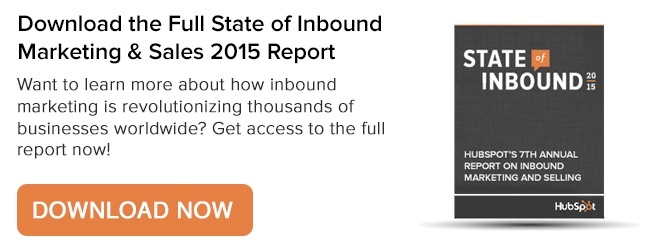Writing that compels someone to take action is kind of like magic. When you write it right, the reader is hooked, directed, and acting before they even really realize what they read. That means when you write a call to action that makes someone download your ebook, book a meeting, or buy a product, you can add “magician” to your job title.
When HubSpot announced its new CTA editor tool in 2023, we looked at the change as a way to make more magic. and undertook a massive marketing operations audit to explore the new tool and decide which CTAs to bring with us and which to leave back in 2014.
As we audited, we learned about our own historical CTA performance and the magical elements that have made some CTAs inspire gasps from the audience and others…fall flat. So what did we learn about writing a great CTA in 2024?
After reading this blog, you will…
- Understand what a call to action is
- Know how to write a great call to action
- Learn from our past call to action examples (and mistakes) to craft your best CTAs
What is a Call to Action?
Your marketing should take people on an easily navigatable step-by-step journey to find a solution to their problem.
A CTA literally calls a visitor to action and invites and nudges them toward that next desired step. That step could be downloading a premium content offer, booking a meeting, subscribing to an email, buying a product, visiting a certain web page, starting a phone call, or many other actions that are logical for the visitor to take.
Often, CTAs are part of a larger conversion path that is designed to turn passive website visitors into identified leads.
A CTA has three basic elements that should be customized to fit where it is placed and where it leads.
- Suggested action: this is your action verb: buy, download, book, read, enroll
- Copy: Your copy can be as simple as just the suggested action, or for a longer CTA it can include a headline, value proposition, feature, etc.
We’re going to focus on the top two in this blog. If you want to learn more about CTA graphics, read this.
- Graphics/Design: This is everything from your font choice, colors, images, button design, background, etc.
CTAs can be used for each buyer’s journey stage. Here are some ideas:
- Awareness:
- Learn more in the next blog
- Save this template
- Download the eBook
- Consideration
- Read the case study
- Use our budget calculator
- Attend the Webinar
- Decision
- Buy now
- Book a meeting
- Request a Demo
How to Write a Magical Call to Action
There are three steps to writing a call to action:
- Hook them
- Keep them
- Lead them
Hook Them
Great call-to-action copy must be enticing and attention-grabbing. Both design and written content contribute to your CTA’s ability to “hook” visitors.
Others may describe the first challenge CTAs face as “the blink test.” In other words, can a page visitor see the value in your CTA and choose to engage with it within only a few seconds-–before they blink?
While the focus of this post is writing calls to action, here is a resource about CTA design.
Attention-grabbing copy might include themes such as:
- Free: Free eBook; Complimentary Consultation; Free 30-Day Trial
- Introduction: Connect with Molly to talk about a website rebuild
- Limited time offers: 10% off today only; 3 spots available; Reservations going fast
- Direct, thought-provoking question: How effective is your ____? Looking for answers?
💡Impulse Creative Tip: Use bold, highlight, or a title/header style setting to make your first statement even more visually impactful.
Another element to hooking your audience is making an emotional connection. Here are a few examples.
- Helpfulness: Struggling with lead generation? We can help.
- Encouragement: Reach your Q2 goals with this workbook.
- Warning: Don’t wait until the last minute to migrate your CTAs.
- Excitement: Ready to learn more? Check out the next step!
- Curiosity: Take a closer look at how AI can impact your marketing.
Of course, your CTAs don’t live in isolation: they’re part of other pieces of content such as website pages, blog posts, social media posts, and emails. With that in mind, your CTAs should also:
- Present a logical, actionable next step
- Be related to the content they’re linked from
- Lead to a landing page with similar language and promises.
A well-written hook will set you up for success in all three areas.
Keep Them
Score! Your hook got the visitor's attention. Now, your copy and design need to add value so that your user actually takes action now that they’ve been called.
The best way to do that is to articulate the value of whatever the offer is. Here are some ideas:
- List some of the features in a bulleted list
- Share a sneak peek
- Skip the wait! Make a CTA demo request that lets users see the product in action immediately.
Lead Them
Now it’s time to seal the deal: Make it easy for your audience to take the next step.
Now is the time to combine actionable language with actionable design. Actionable language will usually mean you want to include verbs in your CTAs. You might use words such as:
- Download
- Request
- Submit
- Vote
- Learn
- Get Started
When you incorporate design, we often recommend using a graphical button to remind the user that they should click. Of course, actionable design will also provide contrast; it doesn’t make sense to use an orange button on an orange page!
Here are some more ideas and best practices to help write the call in your Call to Action:
-
Use “your” or “you” to mentally connect the audience member with the offer already
- Request a consultation for your team
-
Save your guidebook.
-
Show what will be the outcome of taking up this offer.
- Generate Leads Today!
-
Start Your Next Campaign
-
Plainly state what clicking the button does
- Download Your Free eBook.
- Schedule Your Demo
5.5 Call to Action Tips to Write Better CTAs in 2024
1. Make your calls to action actionable.
Action is part of the name of call-to-action! Your CTA must make it clear what clicking it will prompt.
Here’s a list of 100 action phrases if you’re getting stuck in a “Download” rut.
When it comes to the verb you choose to prompt a response, you want it to be focused on the user. What is the value of your offer? What are they getting out of it?
Your audience typically wants one of three things:
-
Teach me
-
Register, read, watch, listen, learn more
-
-
Show me
-
Take a tour, look at, try it today
-
-
Do it for me
-
Buy and save, contact us today, get a quote
-
Example
This CTA doesn’t make it clear what clicking this button will do. Does it lead to a support page, a support email, or a live support representative?

This new pop-up CTA centers the do-it-for-me action: “help” and “talk.”
2. Make your CTAs personal.
Depending on the program you’re using to build your CTA, you can make your CTA personalized to the user. We love and use HubSpot to make our CTAs, so we’ll show you how you can incorporate personalization tokens.
That’s right! Personalization tokens aren’t just for emails. You can use contact or primary company tokens to make the CTA feel a bit more special for returning audience members. Here are a few ideas to get you started:
-
Name-based:
- Hey [first name] we think you will love this eBook!
-
[Company name] - this is made specifically for your marketing team.
-
Location-based
-
Need more leads in [City]? Our Local SEO guidebook is here to help.
-
-
Firmographics-based
-
Book a training session perfect for companies with [company size] team members.
-
-
Preference-based
-
Want to learn more about [interested in]? Subscribe to our YouTube channel.
-
-
Activity-based
-
We’ve lowered our prices since [last marketing email click date]. Buy now!
-
Of course, all of these smart CTAs require a tool like HubSpot and for your contacts to be cookie-tracked in the HubSpot database. Connect with us if you’d like to learn more about setting this up!
3. Watch out for tiny mistakes.
While simple CTAs can be some of the most effective, calls to action are a step in conversion paths that are designed to build trust between you and your audience.
With that in mind, CTAs should be error-free.
Before you hit publish, check the following. Remember, you don’t want to get noticed for the wrong reasons.
- Spelling
- Grammar
- Spacing
- Consistent capitalization protocol
- Alignment
Example

“Ready” is misspelled. 🫣
Here are some tactics to avoid errors:
- Use an AI-assisted spelling and grammar checker like Grammarly.
- Ask a peer to check your work as you check theirs.
- Say it out loud; sometimes hearing it helps you catch illogical phrasing or word choice.
3.5 Easily find what you’re writing - create a consistent naming convention.
Okay, so this isn’t exactly about writing your CTAs, but it contributes to successful CTAs.
When we started our audit of our CTAs, we realized something foundational. We didn’t have a consistent way to name our CTAs.
It’s important to be specific and consistent about your CTA naming because consistent naming conventions give you a way to:
- Search for a specific CTA quickly.
- Identify all of the CTAs within a campaign, product, website page, etc., and edit them all easily.
- Create a system with enough information to clearly identify the placement and intent of the CTA.
We decided on an internal naming convention that includes where the CTA leads, whether it’s an awareness, consideration, or decision stage CTA, the placement, and when it was last updated.
4. Make your CTAs concise and focused.
Get in; get out. That’s the rule of thumb with CTAs. Keep your copy snappy to show the most important information and save the flowery prose for your blogs, premium content offers, and pillar pages.
Research differs on how exactly long a user’s attention span is, but it’s certainly not measured in minutes anymore. So, don’t waste a single second.
This CTA has too much to look at and too much text to fully understand what the offer is at a glance.
Instead of a separate paragraph copy, mockup, and button, we simplified our premium content CTAs to be straightforward, clear, and value-based.
5. Establish urgency and timeliness.
An effective tactic to nudge someone to action is communicating urgency. If your audience thinks they can just come back later and claim whatever the offer is, they probably won’t. You need to raise the stakes while you have their attention.
That being said, use urgency language intentionally. Not everything on your website has a countdown clock. If you use urgency too much, it can come across as too pushy and inauthentic.
Here are some offers that make sense to pair with urgency
- Webinar or course with limited seats
- A special price on a service or product
- Product with a set quantity
- A seasonal offer
Now that you know how to write a call to action
Call to actions are but one lever of your entire marketing strategy.
If you want help putting all the pieces together into one synchronized direction, we’d love to chat.
But if you're just hungry for more marketing insight, check out our Beginner’s Guide to Inbound.











